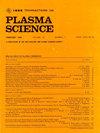The Influence of Ionization and Attachment Coefficients on Positive Corona Onset Characteristics in Dry or Moist Air
IF 1.5
4区 物理与天体物理
Q3 PHYSICS, FLUIDS & PLASMAS
引用次数: 0
Abstract
Ionization and attachment coefficients (IAC) are essential in corona discharge research. However, these parameters of air from different sources vary and are environment-affected. In the present work, the commonly used IAC data in corona discharge research are compared with the data of air calculated by the Monte Carlo (MC) simulation and the Boltzmann equation with different collision cross sections. The results are significantly influenced by both the collision cross sections and the calculation method, and additionally, the effect of humidity on the results is studied. Subsequently, the corona onset voltage of the wire–plane electrode is predicted by the photoionization criterion and measured in an artificial climate chamber. For the first time, the impact of IAC differences on the prediction of positive corona onset voltage under varying environments is analyzed. Experimental comparisons reveal that the impact is marked, especially under varying humidity conditions, where the impact trends are opposite. To ensure the comprehensiveness of the research, the photon absorption coefficient is also analyzed. Finally, according to the comparisons, recommendations for parameter acquisition methods in positive corona discharge research are provided, which will offer valuable insights for addressing corona discharge issues in various environments.电离系数和附着系数对干湿空气中正电晕发生特性的影响
电离和附着系数(IAC)在电晕放电研究中是必不可少的。然而,来自不同来源的空气的这些参数是不同的,并受到环境的影响。本文将电晕放电研究中常用的IAC数据与采用蒙特卡罗(MC)模拟和不同碰撞截面的玻尔兹曼方程计算的空气数据进行了比较。碰撞截面和计算方法对结果都有显著影响,此外还研究了湿度对结果的影响。随后,利用光电离判据预测了线平面电极的电晕起始电压,并在人工气候室中进行了测量。首次分析了不同环境下IAC差异对正电晕起始电压预测的影响。实验对比表明,影响是明显的,特别是在变湿度条件下,影响趋势相反。为了保证研究的全面性,还对光子吸收系数进行了分析。最后,通过比较,对正电晕放电研究中的参数获取方法提出了建议,为解决各种环境下的电晕放电问题提供了有价值的见解。
本文章由计算机程序翻译,如有差异,请以英文原文为准。
求助全文
约1分钟内获得全文
求助全文
来源期刊

IEEE Transactions on Plasma Science
物理-物理:流体与等离子体
CiteScore
3.00
自引率
20.00%
发文量
538
审稿时长
3.8 months
期刊介绍:
The scope covers all aspects of the theory and application of plasma science. It includes the following areas: magnetohydrodynamics; thermionics and plasma diodes; basic plasma phenomena; gaseous electronics; microwave/plasma interaction; electron, ion, and plasma sources; space plasmas; intense electron and ion beams; laser-plasma interactions; plasma diagnostics; plasma chemistry and processing; solid-state plasmas; plasma heating; plasma for controlled fusion research; high energy density plasmas; industrial/commercial applications of plasma physics; plasma waves and instabilities; and high power microwave and submillimeter wave generation.
 求助内容:
求助内容: 应助结果提醒方式:
应助结果提醒方式:


